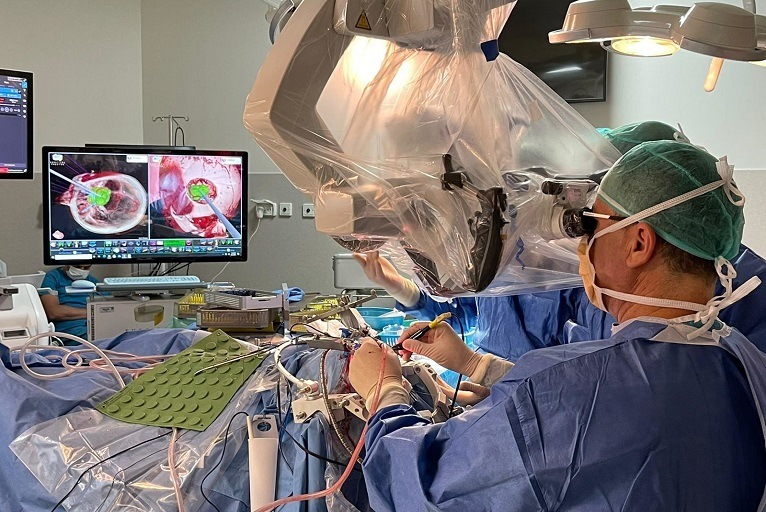When an athlete sustains a spine injury, the focus turns to safe recovery and a return to activity. Whether it’s a professional aiming to rejoin competition or an amateur getting back to training, the stakes can be high. Dr. Larry Davidson, a board-certified neurosurgeon with fellowship training in complex spinal surgery, has been among those leading the shift toward minimally invasive techniques, and the thoughtful use of technology in spine care. Advances in robotic-assisted approaches are being used to support precise, personalized procedures that may reduce tissue disruption and help athletes resume activity sooner.
In the world of spinal surgery, robotic systems provide a higher degree of accuracy and personalization, allowing surgeons to tailor each procedure to the unique anatomy of the patient. It is critical for athletes who rely on their bodies to perform at an elite level. With the precision of robotic tools, surgery can be done more efficiently, minimizing the risk of damage to critical structures and accelerating recovery. Robotic-assisted spine surgery is not just about healing, but also about helping athletes return to their peak performance with confidence.
A New Era of Precision
One of the main advantages of robotic-assisted spine surgery is the added precision it brings to the planning and execution of procedures. In the past, spinal surgery relied entirely on the surgeon’s manual skill, but even experienced surgeons faced limits in visualization and consistency. With robotic systems, surgeons can use detailed 3D imaging and trajectory planning to map out the surgery in advance. Designed for precision, these systems assist with every movement and implant placement, supporting safer, more consistent outcomes.
For athletes, this level of planning can be valuable in cases ranging from herniated discs to complex spinal alignment issues. The ability to visualize and navigate spinal anatomy before and during surgery can help reduce disruption to muscles, ligaments and nerves that are essential to performance.
Minimizing Recovery Time
Robotic-assisted spine surgery is often associated with shorter recovery periods compared to traditional approaches. The use of smaller incisions and techniques that limit disruption to surrounding muscles, ligaments and tissues can make it possible for patients to begin moving sooner after surgery. For athletes, this earlier mobility can be an important factor in planning a safe return to training and competition.
In many cases, hospital stays may be shorter than with open procedures, and rehabilitation can start earlier, depending on the specific surgery and the patient’s overall health. Beginning rehabilitation sooner may help maintain muscle strength, preserve flexibility and reduce the effects of prolonged inactivity. For athletes, this can mean resuming conditioning work under medical guidance, while continuing to protect the surgical site. This measured approach to recovery supports both healing and a gradual return to sport-specific activity.
Safer Returns to Competition
For athletes, returning to competition after spine surgery requires more than simply healing the surgical site. It involves regaining strength, mobility and confidence, while protecting against re-injury. Robotic-assisted spine surgery can support these goals by helping surgeons plan and perform procedures with a high degree of precision. Accurate placement of implants and careful preservation of surrounding tissues may contribute to better spinal alignment and stability, both of which are important for performance and long-term health.
By reducing unnecessary disruption to muscles, ligaments and nerves, this approach aims to limit post-surgical complications such as pain, stiffness or nerve irritation. For athletes, this can mean having a clearer pathway back to training with a lower likelihood of setbacks during recovery. Recovery timelines differ for each person and procedure, but using advanced planning and guidance tools can help set the stage for a safe and confident return to sports.
Athletic Recovery Success Stories
In sports medicine, recovery from a spinal injury often depends on both the quality of the surgical repair and the approach taken to protect surrounding structures. Robotic-assisted spine surgery combines advanced imaging, detailed planning and guided instrumentation to address spinal conditions, with the aim of minimizing tissue disruption. For athletes, this can be an important factor in maintaining the mobility, stability and strength needed for performance.
By tailoring the procedure to the individual’s anatomy, surgeons can plan an approach that supports safe rehabilitation and gradual reconditioning. Minimally invasive techniques, when paired with precise guidance systems, are designed to limit postoperative discomfort and reduce the likelihood of complications that could interrupt recovery. While outcomes vary from one patient to another, these strategies can provide a clear framework for returning to physical activity, with greater confidence.
The Continued Advancements in Robotic Spine Surgery
Developments in surgical technology are continuing to expand the role of robotics in spine care. Surgeons now have access to planning tools, imaging systems and guidance platforms that support greater precision in both preparation and execution. These tools are being refined to improve visualization, enhance accuracy in implant placement and help preserve surrounding tissues.
Researchers are also exploring how emerging technologies, such as artificial intelligence and machine learning, could be incorporated into planning and navigation systems. These capabilities may assist in analyzing surgical data, identifying patterns and supporting decision-making during procedures. By combining these innovations with established surgical expertise, the goal is to further improve consistency, enhance safety and provide care that is tailored to the needs of each patient.
Empowering Athletes with Robotic Precision
Robotic-assisted spine surgery is one of several approaches being used to support more precise and individualized spinal care. By adopting these technologies, Dr. Larry Davidson and other surgeons are advancing patient care, while maintaining strict adherence to surgical best practices. By combining surgeon expertise with modern imaging and navigation systems, procedures can be tailored to each patient’s anatomy, with the goal of minimizing tissue disruption and supporting a safe recovery process.
Ongoing advancements in imaging, planning tools and guidance technology are being explored to enhance accuracy, consistency and personalization in spine surgery. These developments may offer benefits for a wide range of patients, including athletes, by creating conditions that support healing and help maintain long-term spinal health.

